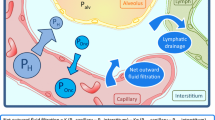Abstract
Purpose
This study examines the correlation between the transpulmonary thermodilution derived extravascular lung water content (EVLW) and the ventilation/perfusion-distribution (\( \dot{V}/\dot{Q} \)) measured by multiple inert gas elimination (MIGET) in a porcine model.
Methods
\( \dot{V}/\dot{Q} \) measured by micropore membrane inlet mass spectrometry-MIGET (MMIMS-MIGET) and EVLW were simultaneously measured in twelve pigs in the heathy state, with impaired gas exchange from repetitive lung lavage and after 3 h of ventilation. The relationship between \( \dot{V}/\dot{Q} \) compartments and EVLW was analysed by linear correlation and regression.
Results
Considerable increases in EVLW and \( \dot{V}/\dot{Q} \) mismatching were induced through the lavage procedure. Significant correlations between the EVLW and the \( \dot{V}/\dot{Q} \) fractions representing pulmonary shunt and low \( \dot{V}/\dot{Q} \) were found. Perfusion to the normal \( \dot{V}/\dot{Q} \) regions was inversely correlated to the EVLW.
Conclusions
Increased EVLW is associated with increased low \( \dot{V}/\dot{Q} \) and shunt, but not equal to pulmonary shunt alone. Beneath true shunt EVLW can also be associated with low \( \dot{V}/\dot{Q} \) regions.



Similar content being viewed by others
References
Wagner PD (2008) The multiple inert gas elimination technique (MIGET). Intensive Care Med 34:994–1001
Baumgardner JE, Choi IC, Vonk-Noordegraaf A, Frasch HF, Neufeld GR, Marshall BE (2000) Sequential V(A)/Q distributions in the normal rabbit by micropore membrane inlet mass spectrometry. J Appl Physiol 89:1699–1708
Brown LM, Liu KD, Matthay MA (2009) Measurement of extravascular lung water using the single indicator method in patients: research and potential clinical value. Am J Physiol Lung Cell Mol Physiol 297:L547–L558
Luecke T, Roth H, Herrmann P, Joachim A, Weisser G, Pelosi P, Quintel M (2003) PEEP decreases atelectasis and extravascular lung water but not lung tissue volume in surfactant-washout lung injury. Intensive Care Med 29:2026–2033
Neumann P, Hedenstierna G (2001) Ventilation-perfusion distributions in different porcine lung injury models. Acta Anaesthesiol Scand 45:78–86
Hartmann EK, Boehme S, Bentley A, Duenges B, Klein KU, Elsaesser A, Baumgardner JE, David M, Markstaller K (2012) Influence of respiratory rate and end-expiratory pressure variation on cyclic alveolar recruitment in an experimental lung injury model. Crit Care 16:R8
Evans JW, Wagner PD (1977) Limits on VA/Q distributions from analysis of experimental inert gas elimination. J Appl Physiol 42:889–898
Duenges B, Vogt A, Bodenstein M, Wang H, Bohme S, Rohrig B, Baumgardner JE, Markstaller K (2009) A comparison of micropore membrane inlet mass spectrometry-derived pulmonary shunt measurement with Riley shunt in a porcine model. Anesth Analg 109:1831–1835
Dantzker DR, Brook CJ, Dehart P, Lynch JP, Weg JG (1979) Ventilation-perfusion distributions in the adult respiratory distress syndrome. Am Rev Respir Dis 120:1039–1052
Easley RB, Mulreany DG, Lancaster CT, Custer JW, Fernandez-Bustamante A, Colantuoni E, Simon BA (2009) Redistribution of pulmonary blood flow impacts thermodilution-based extravascular lung water measurements in a model of acute lung injury. Anesthesiology 111:1065–1074
Bajorat J, Hofmockel R, Vagts DA, Janda M, Pohl B, Beck C, Noeldge-Schomburg G (2006) Comparison of invasive and less-invasive techniques of cardiac output measurement under different haemodynamic conditions in a pig model. Eur J Anaesthesiol 23:23–30
Bein B, Meybohm P, Cavus E, Renner J, Tonner PH, Steinfath M, Scholz J, Doerges V (2007) The reliability of pulse contour-derived cardiac output during hemorrhage and after vasopressor administration. Anesth Analg 105:107–113
Fernandez-Mondejar E, Castano-Perez J, Rivera-Fernandez R, Colmenero-Ruiz M, Manzano F, Perez-Villares J, de la Chica R (2003) Quantification of lung water by transpulmonary thermodilution in normal and edematous lung. J Crit Care 18:253–258
Kuzkov VV, Kirov MY, Sovershaev MA, Kuklin VN, Suborov EV, Waerhaug K, Bjertnaes LJ (2006) Extravascular lung water determined with single transpulmonary thermodilution correlates with the severity of sepsis-induced acute lung injury. Crit Care Med 34:1647–1653
Berkowitz DM, Danai PA, Eaton S, Moss M, Martin GS (2008) Accurate characterization of extravascular lung water in acute respiratory distress syndrome. Crit Care Med 36:1803–1809
Rossi P, Wanecek M, Rudehill A, Konrad D, Weitzberg E, Oldner A (2006) Comparison of a single indicator and gravimetric technique for estimation of extravascular lung water in endotoxemic pigs. Crit Care Med 34:1437–1443
Acknowledgments
The study was funded by the German Research Council (DFG Pak 415, Ma 2398/7).
Conflicts of interest
J. E. Baumgardner, the president of Oscillogy LLC, which commercially manufactures the MMIMS-MIGET system, participated in the study setup and provided technical support. None of the other authors declares a conflict of interest.
Author information
Authors and Affiliations
Corresponding author
Rights and permissions
About this article
Cite this article
Hartmann, E.K., Duenges, B., Baumgardner, J.E. et al. Correlation of thermodilution-derived extravascular lung water and ventilation/perfusion-compartments in a porcine model. Intensive Care Med 39, 1313–1317 (2013). https://doi.org/10.1007/s00134-013-2915-y
Received:
Accepted:
Published:
Issue Date:
DOI: https://doi.org/10.1007/s00134-013-2915-y




